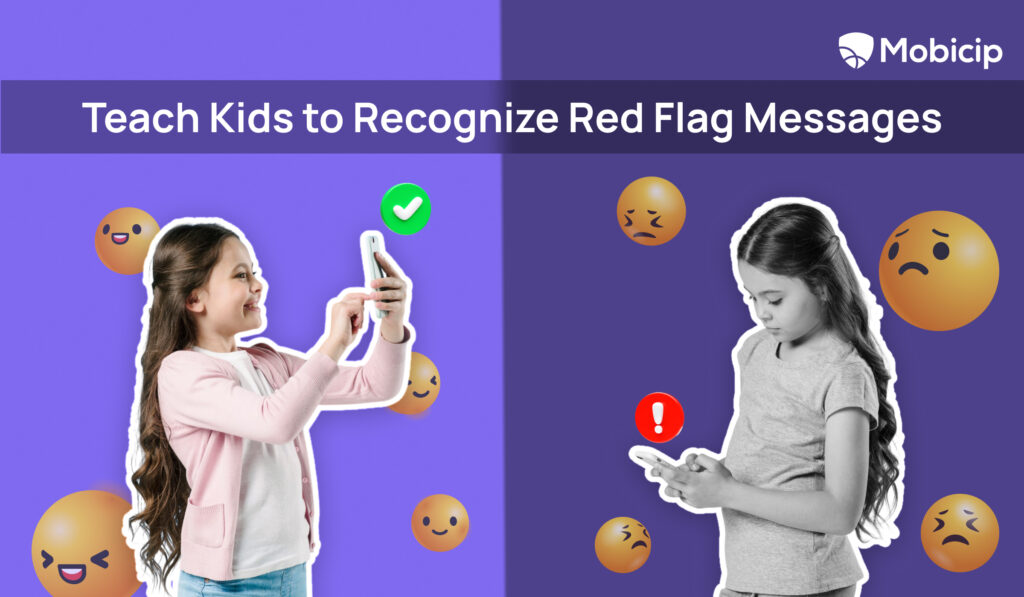Gone in a Flash: How Disappearing Messages Can Impact Your Child’s Online Safety
 The internet is paradoxical. On the one hand, it serves as an eternal repository, capturing our every digital footprint for posterity. Yet, nestled within this vast permanence expanse, a curious phenomenon exists: disappearing messages. It’s a virtual paradox where the ephemeral meets the eternal, raising questions about privacy, spontaneity, and, above all, the safety of our children in the digital world.
The internet is paradoxical. On the one hand, it serves as an eternal repository, capturing our every digital footprint for posterity. Yet, nestled within this vast permanence expanse, a curious phenomenon exists: disappearing messages. It’s a virtual paradox where the ephemeral meets the eternal, raising questions about privacy, spontaneity, and, above all, the safety of our children in the digital world.
What are disappearing messages?
In fiction/fantasy, memory loss, or amnesia, often takes on a romantic, adventurous, or horrifying quality, as the genre demands. Remember Leonard Shelby from the psychological thriller mystery, “Memento“? Stricken with short-term memory loss, he embarks on a relentless quest for answers, navigating a labyrinth of deception and intrigue where nothing is as it seems.
Disappearing data/information is not as romantic or adventurous in the digital world, especially for children and adolescents.
Many messaging platforms offer disappearing messages, a feature that allows users to send texts, images, or videos that automatically delete after a predetermined period. This temporary nature ensures that conversations leave no digital trail, offering users a sense of privacy and spontaneity. Essentially, disappearing messages mimic face-to-face conversations, where words vanish into thin air once spoken, leaving behind no tangible record.
Several popular messaging platforms have integrated disappearing messages into their services, catering to users’ growing demand for privacy and transient communication. Snapchat, renowned for pioneering this feature, allows users to send “snaps” that disappear after being viewed or within 24 hours for Stories. WhatsApp, a widely used messaging app, introduced disappearing messages that vanish after seven days, providing a temporary window for communication.
Signal, known for its focus on privacy and security, offers disappearing messages with customizable expiration times, empowering users with greater control over their digital conversations. Telegram offers “Secret Chats” with end-to-end encryption and self-destructing messages, available even in normal messaging with screenshot notifications. iMessage’s “Undo send” feature allows unsending messages within a two-minute limit, posing similar risks without parental control options.
These platforms, among others, have embraced disappearing messages as a means to cater to users’ desire for privacy and spontaneity in their digital interactions. However, while these features offer convenience, they also pose significant implications for users’ safety, particularly children, in terms of cyberbullying, sexting, and online predation. As such, understanding the mechanics of disappearing messages and their prevalence across various platforms is essential for parents seeking to responsibly navigate their children’s online experiences.
The Appeal of Disappearing Messages
Youngsters and children are particularly drawn to disappearing messages for reasons that vary with their digital behavior and developmental stages. The promise of privacy resonates deeply with this demographic, as they often value autonomy and independence in their digital interactions. Disappearing messages offer a sense of control over their online presence, allowing them to communicate freely without fearing their conversations being monitored or scrutinized by parents or authority figures.
The temporary nature of disappearing messages caters to youngsters’ desire for spontaneity and instant gratification. In this digital era, where attention spans are fleeting, these features enable rapid-fire exchanges without the burden of maintaining a digital trail. This spontaneity fosters a sense of excitement and novelty in communication, appealing to children’s inherent curiosity and penchant for exploration.
The allure of avoiding evidence plays into youngsters’ natural inclination for experimentation and risk-taking. Disappearing messages provide a sense of freedom to engage in conversations or share content that they might otherwise hesitate to do if there were permanent records. This sense of liberation encourages youngsters to express themselves more authentically and take calculated risks in their digital interactions.
Risks Associated with Disappearing Messages
Disappearing messages harbor significant risks, particularly concerning children’s online safety. In 2020, when Facebook introduced disappearing messages, Anna Edmundson, the NSPCC’s head of policy, expressed concerns, stating: “Despite its age restriction, many under-16s use WhatsApp and disappearing messages could put children at greater risk of harm, by providing groomers with yet another tool to avoid detection and erase evidence.”
In February of this year (2024), during a congressional hearing addressing social media platforms’ impact on children and adolescents, US Senator Dick Durbin pointed out the misuse of Snapchat’s disappearing messages, noting: “Snapchat’s disappearing messages have been co-opted by criminals who financially ‘sextort’ young victims.”
Here are some of the risks of Disappearing Messages.
Cyberbullying: The transient nature of disappearing messages can embolden cyberbullies to send hurtful or harassing content knowing that it will vanish without a trace. Victims may struggle to provide evidence of the abuse, making it challenging to address and seek support.
Sexting: Disappearing messages provide a platform for sexting, where individuals share explicit photos or messages that are automatically deleted after a set time. This can lead to the dissemination of sensitive content without consent, putting children at risk of exploitation, blackmail, or emotional distress.
Grooming: Predators may exploit the ephemeral nature of disappearing messages to groom children, gradually building trust and manipulating them into engaging in inappropriate or harmful behavior. Without a permanent record, it becomes harder for victims or authorities to identify and intervene in grooming situations.
Inadequate Oversight: The temporary nature of disappearing messages may encourage children to engage in risky behavior without considering the long-term consequences. Children may unknowingly put themselves in vulnerable situations without proper oversight and guidance from parents or caregivers.
False Sense of Security: Children may develop a false sense of security when using disappearing messages, believing that their conversations are entirely private and immune to scrutiny. This misconception can lead to reckless behavior and a disregard for the potential risks associated with online communication.
False Sense of Privacy: The disappearing messages feature can give youngsters a false sense of privacy. Although the messages do disappear, unsavory elements/bullies may take screenshots of them before they disappear. Users have reported instances of bullying on social media platforms like Snapchat, with their intimate photos being shared widely without their consent.
Parental Concerns and Responsibilities
Parental concerns regarding disappearing messages encompass a spectrum of worries related to their children’s online safety:
Inappropriate Content: Parents fear that their children may be exposed to or engage in conversations involving inappropriate content, including explicit language, images, or discussions facilitated by disappearing messages.
Cyberbullying: The transient nature of disappearing messages can mask instances of cyberbullying, making it difficult for parents to identify if their child is being targeted or harassed online.
Privacy: Parents are concerned about their children’s privacy and the potential risks associated with sharing personal information or engaging in private conversations that malicious individuals could exploit.
Grooming: There is a heightened concern among parents about the risk of predators using disappearing messages to groom children, gradually building relationships and trust to exploit them for nefarious purposes.
Digital Literacy: Parents worry about their children’s ability to navigate online spaces responsibly, including understanding the implications of disappearing messages and recognizing potential risks associated with their use.
Practical Steps for Parents
Parents have a responsibility towards the digital and online safety of their children. Here are some practical steps that parents must take:
Setting Boundaries:
- Establish clear guidelines for messaging app usage, such as setting time limits and defining appropriate content for communication.
- Emphasize the importance of obtaining consent before sharing disappearing messages, ensuring children understand the significance of respecting others’ privacy.
Educating Children:
- Educate children about the potential risks associated with disappearing messages, including cyberbullying, sexting, and grooming.
- Encourage children to report any concerning messages promptly, fostering a sense of responsibility and empowerment in managing their online interactions.
Monitoring Online Activity:
- Monitor your child’s behavior. Any unusual or secretive behavior may be linked to some unpleasant or dangerous communication online. Learn to recognize the signs of such behavior.
- Use parental control apps like Mobicip to monitor children’s messaging activity, providing insight into their online behavior while respecting their privacy. Set up customized filters and restrictions to ensure age-appropriate content and safe browsing habits.


- Regularly review activity reports to identify any potential risks or inappropriate interactions.
Communication:
- Maintain open and ongoing conversations with children about their online experiences, creating a supportive environment where they feel comfortable discussing any issues or concerns.
- Encourage transparency by establishing clear guidelines and boundaries for online behavior.
Privacy vs. Safety:
- Create a balance between privacy concerns and safety precautions, emphasizing that safety should always take precedence, even in digital spaces.
- Explain to children that while privacy is important, it should not come at the expense of their safety and encourage them to prioritize caution and responsible behavior in their online interactions.
FAQs
How can I track my child’s disappearing messages?
Tracking your child’s disappearing messages can be challenging due to the nature of these platforms, which are designed to delete messages after a certain period. Even with open communication and education, children may still exhibit typical rebellious behavior, where curiosity often overrides caution. In such cases, parents can employ parental control apps to monitor their children’s device and messaging usage discreetly, providing an additional layer of oversight and protection in the evolving landscape of online interactions. Parental control apps like Mobicip offer features to help parents monitor and manage disappearing messages on their children’s devices. Mobicip’s features, such as activity reports and message tracking, empower parents to stay informed about their children’s online interactions. By leveraging Mobicip, parents can proactively address any concerns or potential dangers posed by disappearing messages, promoting a safer digital environment for their children.
What should I do if my child receives inappropriate content?
If your child receives inappropriate content, addressing the situation promptly and effectively is important. Stay calm and reassure your child while listening attentively to their concerns. Encourage them to block or delete the sender and content, and consider reporting it to the platform or app provider. Use the incident as an opportunity to educate your child about online safety and adjust privacy settings to minimize future risks. Additionally, consider using parental control apps like Mobicip to monitor and manage your child’s device and messaging usage, providing additional protection. Seek support from counselors or online safety organizations if needed, and maintain open communication with your child about their online experiences.
Are there any secure messaging apps for kids?
Yes, there are several messaging apps designed specifically with children’s safety in mind. For children under the age of 13, apps like Messenger Kids, JusTalk Kids, KidsEmail, Kinzoo, and Stars Messenger offer age-appropriate communication platforms where kids can interact with family members, classmates, and friends in a safe and controlled environment. These apps typically include features such as parental controls, content filtering, and moderated communities to ensure that children can enjoy socializing online while being protected from potential risks and inappropriate content.






